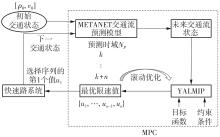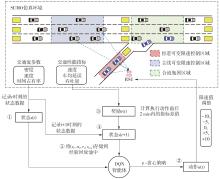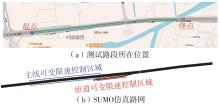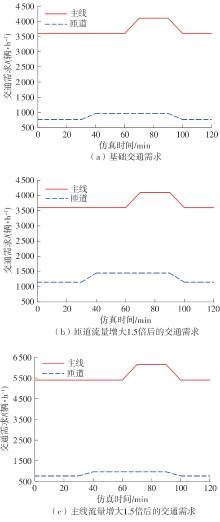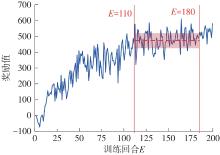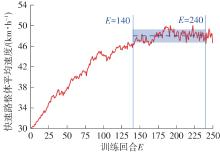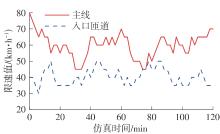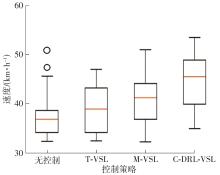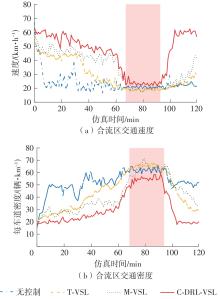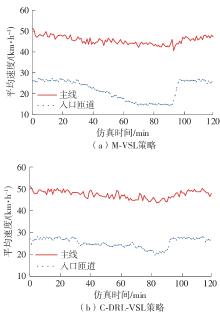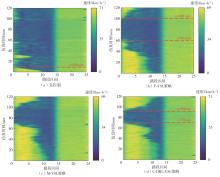Journal of South China University of Technology(Natural Science Edition) ›› 2025, Vol. 53 ›› Issue (8): 73-86.doi: 10.12141/j.issn.1000-565X.240403
• Intelligent Transportation System • Previous Articles Next Articles
Collaborative Control for Urban Expressway Mainline and On-Ramp Metering in Connected-Vehicle Environment
WU Haodu1, SHI Yang1, ZHAO Junteng2, SUN Jian1,2
- 1.School of Transportation Engineering,Chang’an University,Xi’an 710064,Shaanxi,China
2.School of Future Transportation,Chang’an University,Xi’an 710064,Shaanxi,China
-
Received:2024-08-14Online:2025-08-25Published:2025-03-12 -
Contact:孙健(1977—),男,博士,教授,主要从事共享出行与智能交通系统、交通大数据、交通环境及能耗仿真研究。 E-mail:jiansun@chd.edu.cn -
About author:吴昊都(2000—),男,博士生,主要从事交通规划与管理研究。E-mail: wuhaodu@chd.edu.cn -
Supported by:the National Natural Science Foundation of China(52172319)
CLC Number:
Cite this article
WU Haodu, SHI Yang, ZHAO Junteng, SUN Jian. Collaborative Control for Urban Expressway Mainline and On-Ramp Metering in Connected-Vehicle Environment[J]. Journal of South China University of Technology(Natural Science Edition), 2025, 53(8): 73-86.
share this article
Table 4
Simulation results of parameters under different control strategies"
| 控制策略 | 总行程时间/ (辆 | 总行驶距离/ (辆 | 匝道排队 长度/m | 交通流量/ (辆 | 交通密度/ (辆 | 排放量/ (mg·辆-1) | ||||
|---|---|---|---|---|---|---|---|---|---|---|
| 均值 | 标准差 | 均值 | 标准差 | CO2 | NO x | HC | ||||
| 无控制 | 293.98 | 9 847.70 | 184 | 4 041 | 161.67 | 130 | 20 | 888 788.22 | 357.10 | 64.65 |
| F-VSL | 283.49/(-3.57%)1) | 10 977.24/(+11.47%)2) | 162/ (+11.96%)3) | 4 495 | 144.54 | 120 | 26 | 739 990.71/(-16.74%)4) | 295.97 | 52.64 |
| M-VSL | 278.29/(-5.34%)1) | 11 374.88/(+15.51%)2) | 138/ (+25.00%)3) | 4 654 | 158.36 | 115 | 27 | 689 397.96/(-22.43%)4) | 275.39 | 48.80 |
| C-DRL-VSL | 254.61/(-13.39%)1) | 11 834.16/(+20.17%)2) | 86/ (+53.26%)3) | 4 868 | 135.50 | 103 | 23 | 656 371.47/(-26.15%)4) | 261.64 | 46.10 |
Table 5
Performance of each control strategy under different traffic demand scenarios"
| 交通需求场景 | 控制策略 | 交通流量/ (辆∙h-1) | 交通流量 改善百分比/% | 速度标准差/ (km∙h-1) | 速度标准差 改善百分比/% | 匝道排队 长度/m | 匝道排队长度 改善百分比/% |
|---|---|---|---|---|---|---|---|
| 场景1 | 无控制 | 4 102 | — | 1.49 | — | 156 | — |
| F-VSL | 4 256 | 3.75 | 2.62 | -75.84 | 133 | 14.74 | |
| M-VSL | 4 328 | 5.51 | 2.41 | -61.74 | 128 | 17.95 | |
| C-DRL-VSL | 4 459 | 8.70 | 1.46 | 2.01 | 65 | 58.33 | |
| 场景2 | 无控制 | 4 041 | — | 2.03 | — | 184 | — |
| F-VSL | 4 495 | 11.23 | 3.04 | -49.75 | 162 | 11.96 | |
| M-VSL | 4 654 | 15.17 | 3.55 | -74.88 | 138 | 25.00 | |
| C-DRL-VSL | 4 868 | 20.47 | 1.51 | 25.62 | 86 | 53.26 | |
| 场景3 | 无控制 | 5 040 | — | 1.28 | — | 206 | — |
| F-VSL | 5 182 | 2.82 | 1.96 | -53.13 | 185 | 10.19 | |
| M-VSL | 5 278 | 4.72 | 1.88 | -46.88 | 176 | 14.56 | |
| C-DRL-VSL | 5 396 | 7.06 | 1.53 | -19.53 | 134 | 34.95 |
| [1] | ZHAO J, MA W, XU H .Increasing the capacity of the intersection downstream of the freeway off-ramp using presignals[J].Computer-Aided Civil and Infrastructure Engineering,2017,32(8):674-690. |
| [2] | KHONDAKER B, KATTAN L .Variable speed limit:an overview[J].Transportation Letters,2015,7(5):264-278. |
| [3] | 余向华 .快速路瓶颈通行能力陡降动态建模与交通控制机理解析[D].杭州:浙江大学,2023. |
| [4] | PAPAGEORGIOU M, KOSMATOPOULOS E, PAPAMICHAIL I .Effects of variable speed limits on motorway traffic flow[J].Transportation Research Record,2008,2047(1):37-48. |
| [5] | HEGYI A, DE SCHUTTER B, HELLENDOORN H .Model predictive control for optimal coordination of ramp metering and variable speed limits[J].Transportation Research Part C:Emerging Technologies,2005,13(3):185-209. |
| [6] | LIU H, ZHANG L, SUN D,et al .Optimize the se-ttings of variable speed limit system to improve the performance of freeway traffic[J].IEEE Transactions on Intelligent Transportation Systems,2015,16(6):3249-3257. |
| [7] | 周浩,胡坚明,张毅,等 .快速路可变限速与匝道控制协同优化策略[J].交通运输系统工程与信息,2017,17(2):68-75. |
| ZHOU Hao, HU Jianming, ZHANG Yi,et al .A coordinated optimization strategy of variable speed limit and ramp metering for expressway[J].Journal of Transportation Systems Engineering and Information Technology,2017,17(2):68-75. | |
| [8] | ARORA K, KATTAN L .Operational and safety impacts of integrated variable speed limit with dynamic hard shoulder running[J].Journal of Intelligent Transportation Systems,2023,27(6):769-798. |
| [9] | MCCARTT A T, NORTHRUP V S, RETTING R A .Types and characteristics of ramp-related motor vehicle crashes on urban interstate roadways in Northern Virginia[J].Journal of Safety Research,2004,35(1):107-114. |
| [10] | GUO Y, LI Z, SAYED T .Analysis of crash rates at freeway diverge areas using Bayesian Tobit modeling framework[J].Journal of The Transportation Research Board,2019,2673(4):652-662. |
| [11] | CHENG M, ZHANG C H, JIN H,et al .Adaptive coordinated variable speed limit between highway mainline and on-ramp with deep reinforcement learning[J].Journal of Advanced Transportation,2022(1): 2435643/1-11. |
| [12] | WALRAVEN E, SPAAN M T J, BAKKER B .Traffic flow optimization:a reinforcement learning approach[J].Engineering Applications of Artificial Intelligence,2016,52:203-212. |
| [13] | ZHU F, UKKUSURI S V .Accounting for dynamic speed limit control in a stochastic traffic environment:a reinforcement learning approach[J].Transportation Research Part C:Emerging Technologies,2014,41:30-47. |
| [14] | GREGURIĆ M, KUŠIĆ K, VRBANIĆ F,et al .Variable speed limit control based on deep reinforcement learning:A possible implementation[C]∥Proceedings of the 2020 International Symposium ELMAR.[S.l.]:IEEE, 2020:67-72. |
| [15] | 白如玉,焦朋朋,陈越,等 .基于强化学习的车道级可变限速控制策略[J].交通信息与安全,2024,42(1):105-114. |
| BAI Ruyu, JIAO Pengpeng, CHEN Yue,et al .Di-fferential variable speed limit control strategy based on reinforcement learning[J].Journal of Transport Information and Safety,2024,42(1):105-114. | |
| [16] | 韩磊,张轮,郭为安 .混合交通流环境下基于改进强化学习的可变限速控制策略[J].交通运输系统工程与信息,2023,23(3):110-122. |
| HAN Lei, ZHANG Lun, GUO Weian .Variable speed limit control based on improved dueling double deep Q network under mixed traffic environment[J].Journal of Transportation Systems Engineering and Information Technology,2023,23(3):110-122. | |
| [17] | WU J, QU X .Intersection control with connected and automated vehicles: a review[J].Journal of Intelligent and Connected Vehicles,2022,5(3):260-269. |
| [18] | VRBANIĆ F, TIŠLJARIĆ L, MAJSTOROVIĆ Ž,et al .Reinforcement learning-based dynamic zone placement variable speed limit control for mixed traffic flows using speed transition matrices for state estimation[J].Machines,2023,11(4):479-494. |
| [19] | WANG X, ZHANG R, GOU Y,et al .Variable speed limit control method of freeway mainline in intelligent connected environment[J].Journal of Advanced Transportation,2021(1):8863487/1-12. |
| [20] | 邵敬波,黄轲,张兆磊,等 .高速公路连续瓶颈混合交通流可变限速与换道协同控制方法[J].交通信息与安全,2023,41(3):59-68,79. |
| SHAO Jingbo, HUANG Ke, ZHANG Zhaolei,et al .A cooperative control method of variable speed limit and lane change for mixed traffic flow on continuous bottlenecks of freeway[J].Journal of Transport Information and Safety,2023,41(3):59-68,79. | |
| [21] | KONTORINAKI M, SPILIOPOULOU A, RONCOLI C,et al .First-order traffic flow models incorporating capacity drop:overview and real-data validation[J].Transportation Research Part B:Methodological,2017,106:52-75. |
| [22] | PAPAGEORGIOU M, PAPAMICHAIL I, SPILIOPOULOU A D,et al .Real-time merging traffic control with app-lications to toll plaza and work zone management[J].Transportation Research Part C:Emerging Technologies,2008,16(5):535-553. |
| [23] | HADIUZZAMAN M, QIU T Z, LU X Y .Variable speed limit control design for relieving congestion caused by active bottlenecks[J].Journal of Transportation Engineering,2013,139(4):358-370. |
| [24] | DERVISOGLU G, GOMES G, KWON J,et al .Automatic calibration of the fundamental diagram and empirical observations on capacity[C]∥Proceedings of the Transportation Research Board 88th Annual Meeting. Washington D C:TRB,2009:31-59. |
| [25] | GAO H, JIA H, WU R,et al .Variable speed limit control for mixed traffic flow on highways based on deep-reinforcement learning[J].Journal of Transportation Engineering,Part A:Systems,2024,150(3):04023147/1-19. |
| [26] | AHMIC K, TAHIRBEGOVIC A, TAHIROVIC A,et al .Simulation framework for platooning based on gazebo and SUMO[C]∥Proceedings of the 2020 IEEE 3rd Connected and Automated Vehicles Symposium (CAVS). Victoria:IEEE,2020:1-7. |
| [27] | 姚志洪,顾秋凡,徐桃让,等 .考虑时延的智能网联汽车混合交通流稳定性分析[J].控制与决策,2022,37(6):1505-1512. |
| YAO Zhihong, GU Qiufan, XU Taorang,et al .Stability of mixed traffic flow with intelligent connected vehicles considering time delay[J].Control and Decision,2022,37(6):1505-1512. | |
| [28] | JIA D, NGODUY D, VU H L .A multiclass microscopic model for heterogeneous platoon with vehicle-to-vehicle communication[J].Transportmetrica B:Transport Dynamics,2019,7(1):311-335. |
| [29] | 秦严严,王昊,王炜,等 .混有协同自适应巡航控制车辆的异质交通流稳定性解析与基本图模型[J].物理学报,2017,66(9):094502/1-9. |
| QIN Yanyan, WANG Hao, WANG Wei,et al .Stability analysis and fundamental diagram of heterogeneous traffic flow mixed with cooperative adaptive cruise control vehicles[J].Acta Physica Sinica,2017,66(9):094502/1-9. | |
| [30] | 孙健,宋茂星,邱果,等 .基于电动汽车大数据的多等级充电站选址与服务能力研究[J].中国公路学报,2024,37(4):48-60. |
| SUN Jian, SONG Maoxing, QIU Guo,et al .Location and service capability of multilevel charging stations based on electric vehicle big data[J].China Journal of Highway and Transport,2024,37(4):48-60. |
| [1] | ZHONG Shaopeng, LIU Ao, ZHAI Junnuo, FAN Meihan, LI Xiyao, LIN Yuan, LI Zhenhua. Review of Multi-Level Urban Impacts of Shared Autonomous Vehicles [J]. Journal of South China University of Technology(Natural Science Edition), 2025, 53(6): 104-118. |
| [2] | LEI Cailin, ZHAO Cong, LOU Ren, JI Yuxiong, DU Yuchuan. Quality Assessment Method of Vehicle Trajectory Data from Roadside Perception [J]. Journal of South China University of Technology(Natural Science Edition), 2024, 52(6): 56-72. |
| [3] | ZHANG Yunchao, HUANG Jianling, LI Yongxing, et al. Online Driving Style Recognition Method Considering Lane-Changing Game [J]. Journal of South China University of Technology(Natural Science Edition), 2024, 52(4): 126-137. |
| [4] | ZHANG Jianhua, ZHAO Xiaohua, OU Jushang, et al.. Evaluation of Utility and Optimal of Variable Speed Limit Value for Bridge in Foggy Condition [J]. Journal of South China University of Technology(Natural Science Edition), 2024, 52(1): 127-138. |
| [5] | . Effect of Combination Mode of Traffic Guidance Information on Route Decision-Making [J]. Journal of South China University of Technology (Natural Science Edition), 2017, 45(8): 77-83. |
| [6] | WANG Ze-sheng DONG Bao-tian WANG Ai-li. Pedestrian Detection Method Based on Adaptive Pulse-Coupled Neural Networks [J]. Journal of South China University of Technology (Natural Science Edition), 2017, 45(6): 74-80. |
| [7] | WEN Hui-ying LIU Min WANG Hai-wei. A Control Method of Variable Speed Limits for Highway Mountain Breeze Transit Road in Rainy Days [J]. Journal of South China University of Technology (Natural Science Edition), 2016, 44(12): 67-73. |
| [8] | Qin Hua-biao Xiao Zhi-yong . A Position-Based Stable Clustering Routing Protocol [J]. Journal of South China University of Technology (Natural Science Edition), 2010, 38(6): 1-6. |
| [9] | Tian Sheng Xu Lun-hui Liao Ran-kun Yang Ya-zao. Control of On-Ramp of Annular Expressways Based on Priority Entrance [J]. Journal of South China University of Technology (Natural Science Edition), 2010, 38(3): 47-52. |
| [10] | Wen Hui-ying Xu Jian-min Zou Liang. Genetic Algorithm-Based Computation of the Shortest Path in Discrete-Time Dynamic Networks [J]. Journal of South China University of Technology (Natural Science Edition), 2008, 36(2): 13-16,28. |
| [11] | Huang Ling Xu Jian-min. Dynamic Traffic Congestion Prediction Model Based on Probe Vehicle Technology [J]. Journal of South China University of Technology (Natural Science Edition), 2008, 36(10): 47-50,56. |
| [12] | Shi Sheng-li Xu Jian-min Qin Zhong. Vehicle Positioning ßased on CDMA and GSM Networks [J]. Journal of South China University of Technology (Natural Science Edition), 2007, 35(2): 50-53. |
| [13] | Zhong Hui-ling Xu Jian-min Peng Xuan-rong. Solution to and Analysis of the Model of Dedicated Short-Range Communication Protocol [J]. Journal of South China University of Technology (Natural Science Edition), 2005, 33(6): 18-22. |
| [14] | Zhong Hui-ling Xu Jian-min Peng Xuan-rong. Establishment of Dedicated Short-Range Comm unication Protocol Model [J]. Journal of South China University of Technology (Natural Science Edition), 2005, 33(4): 34-38. |
| [15] | Hu Yu-cong, Xu Jian-min, Wu Yi-min, et al. Fusion Model of Vehicle Positioning Based on BP Neural Network [J]. Journal of South China University of Technology(Natural Science Edition), 2004, 32(2): 46-49. |
| Viewed | ||||||
|
Full text |
|
|||||
|
Abstract |
|
|||||


